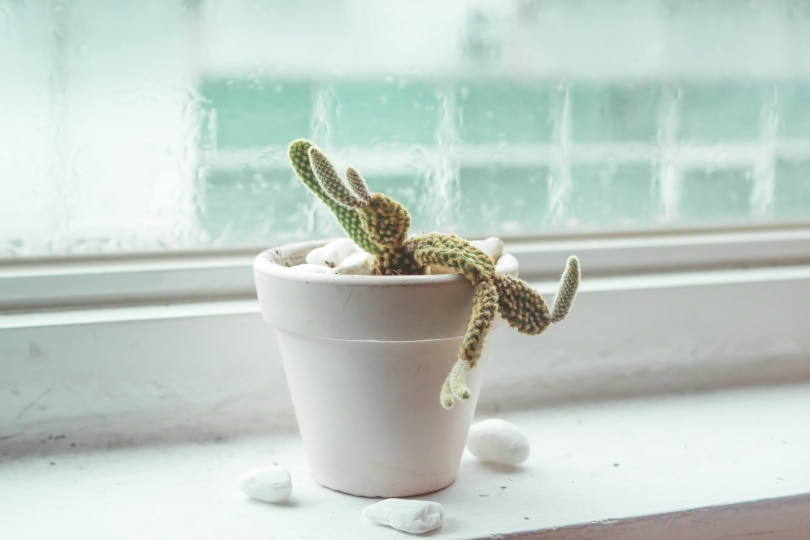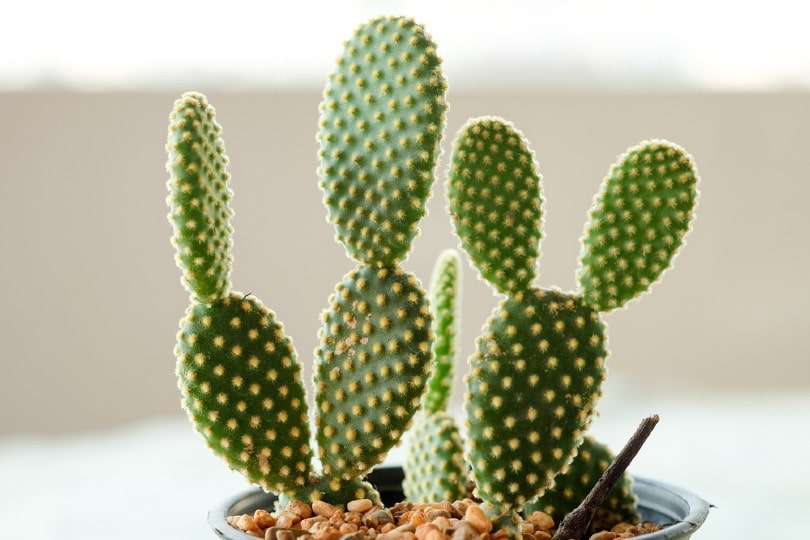How to Tell if a Cactus Is Dead: Signs, Tips & Tricks
-

- Last updated:

Cacti are one of the most popular houseplants, and for good reason! They’re easy to care for and add a touch of greenery to any room. They are tough plants that can endure a lot of neglect, but that doesn’t mean they don’t need any care at all. Like all plants, cacti will eventually die if not taken care of properly.
If you have been growing cacti for a while, you know they can go through dormancy periods. At this time, it can be hard to tell if it’s really dead or just resting. But you mustn’t confuse dormancy and death.
Fortunately, there are some telltale signs that your cactus is on its last legs. By being aware of these indicators, you can take steps to save your plant or simply enjoy it for the time being. In this article, we will discuss how to tell if a cactus is dead. We’ll also tell you what you can do to save a dying cactus. With this, you can take appropriate measures before it becomes too late for your precious plant.
The 7 Telltale Signs of a Dead Cactus
Identifying whether a cactus is dead can be a challenging task- cacti grow slowly. So, this is another reason it’s hard to tell if it might be dead.
The cactus might appear as if it has some life, but several indicators will tell you with confidence when it’s over.
Here they are!
1. Cactus Is Shaky in the Soil

The first step is to check whether your cactus plant is shaky in the soil. If your cactus is still sitting in its pot, but it’s starting to shake and move around, it might be dead.
If you move the pot around, you should notice the cactus “rattling” inside. It is because there aren’t any roots holding the plant down anymore, so it’s just moving around freely in the soil. The weight of the plant will cause it to lean or tip over.
Usually, this is caused by root rot due to underwatering or overwatering. If you observe this sign, your cactus is dead.
2. Cactus Becomes Discolored
You may notice yellow and discolored patches on your cactus. Too much watering makes your cacti mushy and soft, while too little watering makes it dry and husk-like.
If your cactus has become discolored, you should inspect the roots and soil to see if they are still alive. If they are not, it’s likely that the plant is dying and has lost its ability to absorb water and nutrients from the soil.
If this is the case, there’s no hope for recovery. So, it’s best to remove it from its potting soil before it can spread any further damage to other plants in your collection.
But remember that cacti can change color due to other reasons. So you may want to monitor your cactus for a couple of weeks and note how it changes color. During this period, ensure you’re caring for it as needed.
3. Your Cactus Loses Spikes

Spikes are one of the most obvious signs of life in a cactus. If some of them have fallen off over time, that’s normal! But, if many of them are missing, your cactus plant might be dead or dying from root rot.
Before they fall off, you’ll notice black or brown discoloration on the spikes. Remove this cactus from its potting medium as soon as possible. This way, it won’t spread root rot to nearby plants in your collection or garden bed.
4. Cactus Is Covered in Fungi or Mold
If your cactus is covered in fungus or mold, it’s a sign that the plant has been sitting in too much water and it has begun to rot or it is dead already.
If you have a lot of cacti and only one or two are covered in fungus or mold, there’s a good chance they’re suffering from too much humidity.
Fungus and mold are common problems with succulents, but they can also be caused by overwatering. So, if you notice it early enough, handle it as soon as possible. It’ll die fast if you let it settle on your cactus for long.
5. Leaves Drooping on Cactus

Cacti store water in their stems and leaves so they can survive long periods without rainfall or watering. Drooping leaves mean that the plant is overwatered. At this point, it could most likely be dead or close to death if left untreated.
The leaves should be firm and healthy looking and not loose or pointing downward.
6. Cactus Is Light and Hollow
When your cactus dies during the winter months, it will leave behind a hollowed-out stem that’s light and has an airy feeling.
Pick up the cactus and shake it. If all its parts feel hollow or light, it’s a sign that it’s beginning to die. This happens because the moisture has evaporated from the stem, leaving nothing but air pockets. It will still have a green color on the outside, so keep an eye out for that as well.
7. Cactus Plant Wilts

Wilting is the most obvious sign that something is wrong with your cactus. If a leaf wilts and turns brown, it has lost its water supply. Besides, it can no longer function well.
If your cactus wilts without visible signs of moisture in the soil, this could be caused by low temperature or too much sun exposure. Also, inspect the roots to see if they’re rotting. It can make the cactus plant wilt even if it’s getting enough water.
To prevent these problems, try moving your cactus plant indoors during the winter months or into a shadier area during the summer months.
Tips for Reviving a Dying Cactus
Cacti are known for their ability to survive in extremely dry conditions, but they need some water to stay healthy. If your cactus is dying, you can revive it with a few simple steps.
Cut the Rotting Parts of the Cactus
If your cactus is dying, cut off any rotten parts it may be having and leave only healthy green ones. It’ll save your plant from further damage. If there are several dead spots on your plant, cut them off completely and throw them away. The more rotten parts you cut off, the better chance your cactus has to survive.
Adjust Watering Your Cacti
Add water to shrinking or wilting cacti but let the soil dry completely before watering to prevent root rot. Adjust the watering schedule depending on the season and the temperature.
Control Insects and Pests
Insects such as aphids and mites can cause damage to cacti by sucking out their sap. These insects and pests cause yellow discoloration and make the cactus sick. The insects can also spread diseases from one plant to another.
Check for damage when you see signs of infestation such as insects crawling along the plant’s stems or leaves. Then, treat it accordingly with insecticides or organic control methods, like neem oil spray.
The most common cause of cactus death is mealybugs. These white, cottony creatures suck sap from the plant and leave it dehydrated and weak. If you see any fuzzy, cotton-like growth on your cactus, it is likely mealybugs. You can remove them easily with some soap and water. You can also use a cotton swab saturated in denatured alcohol.
Rinse Off Dust and Dirt
If the cactus is dusty or dirty, use a soft brush, rag, or sponge to wipe it. Be careful not to damage the spines-they can break off if pushed too hard. Use water to rinse away any remaining dirt or dust from the plant. Rinsing off dust and dirt from your cacti allows them to process light well.
Apply Low Nitrogen Fertilizer
If your young cactus has been dying due to a lack of water and sunlight, you may need to give it extra nutrients. A low-nitrogen fertilizer will help your cactus rebound faster than other fertilizers.
Some fertilizers contain higher amounts of nitrogen that can damage leaves and stems if too much is applied. The best fertilizer ratio for young cacti is 10-30-20 (nitrogen, phosphorus, and potassium).
- Observing your cacti from time to time is key to keeping them healthy and alive.
- Overwatering your cacti can do more harm than good.
- Take action immediately if you see any of the signs we discussed above.
- Proper drainage will prevent root rot.
- Ensure your cacti get their daily recommended sunlight to prevent mold and fungi.
- Pests and insects can fasten the death of your cacti, so be on the lookout.
Conclusion
Cacti are persistent little plants, but they don’t last forever. Sooner or later, you may find that one or more of your cacti is dead. We have discussed a few signs to look out for if you’re unsure whether your cactus is dead or alive.
If it’s not dead yet but on the verge of dying, you can try to revive it with a few treatment plans such as watering the right way, cutting off the affected/rotting parts, and adding fertilizer. Just learn how to spot the signs and use your best judgment about whether to toss away the plant or do something to revive it.
Featured Image Credit: Boyloso, Shutterstock
Contents


